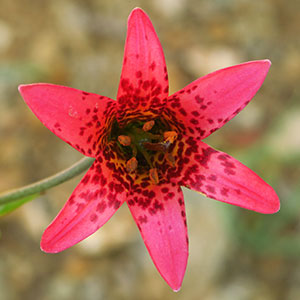Lilium bolanderi
Lilium parryi
Bolander's lily
lemon lily, Parry lily
± ovoid, 3.5–7.9 × 2.6–5.3 cm, 0.9–2.1 times taller than long;
scales unsegmented, longest 3–5.7 cm;
stem roots absent.
rhizomatous, unbranched, continuously scaly, 1.5–4.7 × 3.5–11 cm, 0.2–0.6 times taller than long;
scales (1–)2(–4)-segmented, longest 0.9–3.7 cm;
stem roots absent.
to 1.1 m, glaucous.
to 1.9 m. Buds rounded in cross section.
rounded in cross section.
in 1–5(–6) whorls or partial whorls, 3–19 leaves per whorl, ascending and often cupping stem, 1.8–7.1 × 0.7–2.8 cm, 2.2–4.8 times longer than wide;
blade ± obovate, oblanceolate, or occasionally elliptic, noticeably glaucous, margins nearly always undulate, apex widely acute;
veins and margins ± smooth abaxially.
occasionally scattered in young plants or in 1–5 whorls or partial whorls, 3–18 leaves per whorl, ± horizontal and drooping at tips or ascending, 7.8–29 × 0.5–4.9 cm, 2.6–29 times longer than wide;
blade elliptic to narrowly linear, or ± obovate, often lanceolate in distal leaves, margins not undulate, apex acute, often narrowly so;
veins and margins ± smooth abaxially.
usually umbellate in small plants, in large plants racemose or in 2 whorls, 1–9-flowered.
racemose, 1–31-flowered.
nodding to horizontal, not fragrant;
perianth ± campanulate or funnelform;
sepals and petals somewhat recurved 3/5–4/5 along length from base, red or magenta, occasionally salmon pink or pale yellow, with maroon spots, often yellowish on proximal 1/3–1/2, not distinctly clawed;
sepals not ridged abaxially, 3.1–4.7 × 0.7–1.2 cm;
petals 3–4.5 × 0.7–1.1 cm;
stamens included;
filaments barely spreading, diverging 0°–12° from axis;
anthers reddish or magenta, 0.3–0.8 cm;
pollen rust, orange, or yellow;
pistil 2.1–3.5 cm;
ovary 1–2.1 cm;
style green, rarely reddish purple;
pedicel 0.8–14.2 cm.
opening before dusk, horizontal or somewhat nodding, slightly bilaterally symmetric, strongly fragrant;
perianth funnelform;
sepals and petals recurved 3/5 along length from base, lower less recurved than upper and forming landing platform, bright yellow with sparse, usually minute maroon spots, not distinctly clawed;
sepals not ridged abaxially, oblanceolate, 7.7–10.7 × 1.1–1.7 cm;
petals noticeably wider than sepals, often very wide distally, 7.8–10.6 × 1.1–2.1 cm, apex widely acute or sometimes obtuse;
stamens barely exserted;
filaments barely spreading, diverging at 5°–12°;
anthers pale magenta-brown, 0.8–1.4 cm;
pollen rust-orange or orange-brown;
pistil 5.3–9.3 cm;
ovary 1.6–2.9 cm;
style green, often pale;
pedicel 2–17.5 cm.
2–4.1 × 1.2–2.1 cm, 1.4–3 times longer than wide.
3.9–5.9 × 1.1–1.7 cm, 2.5–4.4 times longer than wide.
90–210.
141–303.
= 24.
= 24.
Lilium bolanderi
Lilium parryi
I. M. Johnston (1923) noted that Lilium bolanderi Watson was based on a mixed collection including L. kelloggii, and he argued that Watson intended the name to apply primarily to the latter species. Thus he proposed the name L. howellii for this diminutive, red-flowered, serpentine endemic. A. D. Cotton (1936) correctly concluded that Watson’s description applied primarily to the specimens here called L. bolanderi, and this view is now widely accepted.
Lilium bolanderi hybridizes with L. rubescens, L. washingtonianum subsp. purpurascens, and subspecies of L. pardalinum.
Bolander’s lily is primarily pollinated by Allen’s and rufous hummingbirds (Selasphorus spp., family Trochilidae).
(Discussion copyrighted by Flora of North America; reprinted with permission.)
Plants in Arizona start to bloom in May (T. H. Kearney and R. H. Peebles 1960), while the majority of California plants flower in July and August.
Plants from the San Gabriel Mountains of California sometimes have wider leaves and have been given status as Lilium parryi var. kessleri, but this variation is due primarily to the rather shaded habitat of many of these populations. No significant vegetative discontinuity can be recognized across the range of this species, so no varieties are recognized here.
Lilium parryi probably arose from an ancestor in common with L. pardalinum (M. W. Skinner 1988), and subsequently diverged to become pollinated by various hawkmoths (family Sphingidae). The flowers are remarkably similar in form and function to those of L. washingtonianum, which is also moth-pollinated, but this resemblance is due to evolutionary convergence.
(Discussion copyrighted by Flora of North America; reprinted with permission.)


